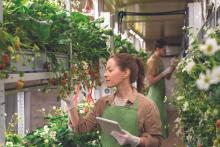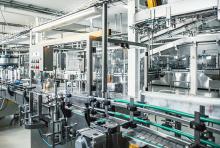- Support portal
- Evaluation Kits and partner products
u-blox Support
- Product documentation
Documentation
- Investor relations
Investor relations
Insights
|
22 Nov 2018
The promise of the connected food industry
The food sector is abuzz with efforts to digitalize its every aspect, from the farm to the front page of the online store. We invited Haiao Ding, Associate Chief Editor at Digital Business Times to discuss how digitalization will impact the food supply chain with Perry Zhang, Principal, Strategic Partnerships at u-blox.

The interview has been edited and condensed for publication on our blog. A more in-depth version is available in our u-blox magazine, Connected Food.
Can the IoT help prevent food loss and waste, across the food supply chain?
Perry ZHANG: Food loss is a big problem in the food industry. Statistics show that more than 30 percent of food is spoiled in the entire production and transportation process. New technologies can help the industry save food and improve efficiency. For example, one of our customers has developed a box for frozen food, which allows them to monitor the temperature, humidity, and light conditions throughout the entire logistics process. If at any time in the logistics process the temperature goes beyond a preset range, an alarm is triggered, followed by corresponding behaviors to adjust ambient temperature and conditions.
Haiao DING: Will the food utilization rate be increased if food supply chain management becomes more precise? A domestic company engaged in intelligent logistics recently launched a new product to control the temperature, humidity, and quality of fresh products and minimize food loss during transportation. If such technology allows every point at every link of the food supply chain to be recorded, controlled, and adjusted without human intervention, companies will be able to improve their efficiency and reduce food loss during transportation. When this reduction reaches a threshold, the food waste in the whole food supply chain will become negligible. I think this might happen after IoT application becomes very mature.
What technology innovations do you see as particularly important for a smart food supply chain?
Perry ZHANG: In my view, low power wide area (LPWA) wireless technology has brought the greatest benefits to the food industry. LPWA technology can significantly reduce the size and power consumption of the batteries, greatly prolonging the life cycle of traditional monitors or trackers. With LPWA technology, we can place a collar with an embedded LPWA module around the neck of each dairy cow to monitor its physical status and send data, including its body temperature and breath count, to the server to determine when it is in heat. One of our customers, a diary enterprise in Ningxia, has applied such an NB-IoT-based solution, greatly increasing their milk production.
Haiao DING: Different scenarios require different technologies, such as IoT, AI, cloud computing, or big data, which will all be widely applied across the entire food supply chain. There’s an e-commerce company that is using AI technologies in an experimental project involving unmanned delivery vehicles. Big data plays a similar enabling role in marketing: Unmanned supermarkets and emerging self-retail aim to tap into the value of data. We can see all kinds of technologies playing roles in the IIoT of food industry, but each is applicable to different IIoT scenarios.
How and by when do you think these technologies could be globally implemented?
Perry ZHANG: According to the GSMA[1], 30 operators in the world have deployed 60 Narrowband IoT (NB-IoT) and LTE-M commercial networks. Most operators in Asia-Pacific and Europe are deploying NB-IoT commercial networks, while those in North America are deploying LTE-M. We can say the IoT technologies, especially LPWA, are ready for a burst of application growth.
Haiao DING: How can IoT can achieve the greatest development in the food industry? We should pay attention to the point at which IoT technologies, on the horizontal axis, can maximize the business value of a company, and help the company minimize costs. This point is where IoT technologies will have a burst of application growth. So far we have seen wide applications of IoT in logistics and processing. And I would tell you that in China, logistics and production will lead the food industry onto an IoT fast track. But it is difficult to predict when this burst of application will arrive, because new technologies keep emerging.
How can we guarantee food safety, from food production to transportation?
Perry ZHANG: Food safety incidents break out from time to time. Generally, we have no idea where food products come from. If you don't know the food source, you are unable to find what caused the incident. IoT can make a difference in this industry by enabling end-to-end management and control, and realizing data transparency and authenticity across the entire industry chain.
There is another very important factor. Many links of the food industry are isolated islands. For example, there is little interaction between agriculture, food processing, logistics, distribution, and sales, making it hard to trace where a product comes from, where it goes, and when. But these facts are directly related to our food safety. Therefore, we urgently need of a set of technologies – including IoT – to connect these islands, and big data and the cloud to usher in new business models to realize whole-process control of the food supply chain.
Haiao DING: To address the food safety issue, we should give priority to unifying standards across the food supply chain. Otherwise, different industries have different understandings about food safety. Data security is an important factor to ensure food safety across the food supply chain. Because if everybody in the industry chain can see and share the food data, and make sure it’s exclusive, real-time, effective, and cannot be falsified, then food safety can be guaranteed from the front-end to the back-end.
Perry ZHANG: We have seen a number of food safety incidents in enterprises that falsified food data. We are convinced that big data and blockchain, currently a hot topic, can play a very critical role here. We believe that blockchain will have bright application prospects across the food industry, because it offers unified and consistent data management across the food supply chain.
How do you see the future of the smart food supply chain?
Perry ZHANG: Blockchain can realize end-to-end control across the food chain. But to do so it needs data, which has to be collected via the IoT, especially using LPWA. As a result of its low power wide area feature, LPWA can be applied at every link of the food industry, from production to logistics to sales, to transfer data to the application server that controls and manages the whole blockchain.
Haiao DING: About 10 years ago, after QR codes were introduced, almost all food products sold in supermarkets started to carry QR codes overnight. All of the data collected via the mobile Internet is now ready to play a big role in any industry in need.
Looking at the overall environment, I think the smart food supply chain will soon embrace explosive growth, with new technologies emerging to fill in gaps, making sure that the explosive growth is a sustainable process with rising momentum.
Perry ZHANG: I think the application of new technologies in the food industry has just entered the initial stage. We can see that the IoT has been deployed in some links of the food industry. But in my view, its real explosive growth will arrive when all links of the food industry have deployed the IoT.
Read the complete interview in the u-blox U magazine.
Watch the interview:

[1] Global System for Mobile Communications Association



